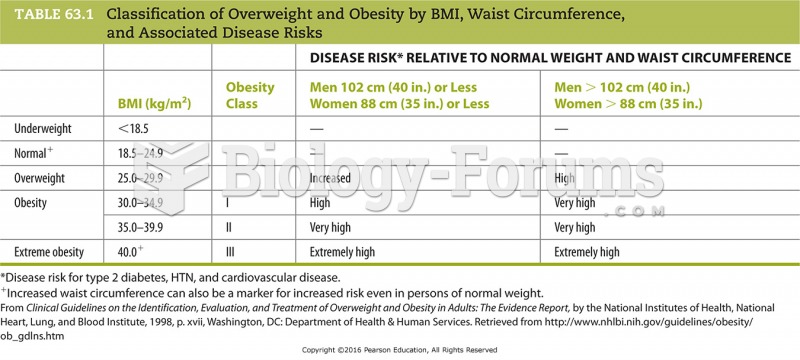Obesity generally is defined as an accumulation of fat (adipose tissue) beyond what is considered normal for a person's age, sex, and body type. In today's society obesity is considered a disease, not a moral failing. It occurs when energy intake exceeds the amount of energy expended over time. Only in a small minority of cases is obesity caused by such illnesses as hypothyroidism, or the result of taking medications, such as steroids, that can cause weight gain. The more a person weighs, the more blood vessels the body needs to circulate blood throughout the body. The heart takes on a heavy burden as it has to pump harder to force the blood flow through so many vessels. As a result, the heart grows in size and blood pressure tends to rise. Obesity is also a factor in osteoarthritis (because of the extra weight placed on the joints), gout, bone and joint diseases (including ruptured intervertebral discs), varicose veins, respiratory ailments, gallbladder disease, complications during pregnancy and delivery, and higher accidental death rate. Obesity can alter hormone levels, affect immune function, and cause impotence in men and reproductive problems in women. Women who are 30 overweight are twice as likely to die of endometrial cancer, and those who are 40 overweight have four times the risk. Obese women also are more likely to incur cancers of the breast, cervix, ovaries, and gallbladder. Obese men are more likely to develop cancers of the rectum, colon, esophagus, bladder, pancreas, stomach, and prostate. Obesity can also cause psychological problems. Sufferers are associated with laziness, failure, or inadequate willpower. As a result, overweight men and women blame themselves for being heavy, thus causing feelings of guilt and depression. Scientific evidence has found an association between BMI (body-mass index) and higher death rates. However, the relative risk of being heavy declines with age. Some researchers have found that data linking overweight and death are inconclusive, while other researchers have found that losing weight may be riskier than dangers posed by extra pounds. Some researchers counter that overweight indirectly contributes to over 300,000 deaths a year. A poll by Shape Up America found that 78 of overweight or obese adults have abandoned dieting as a means of losing weight. Diets do not teach people how to eat properly. They merely restrict food intake temporarily, so when the diet ends, weight gain resumes. From this passage, you can conclude that
a. older obese persons have greater risks than do younger people who areobese.
b. obese people often blame other people for their condition.
c. obesity is not a major health risk.
d. people are likely to be biased against those who are obese.
Question 2
Obesity generally is defined as an accumulation of fat (adipose tissue) beyond what is considered normal for a person's age, sex, and body type. In today's society obesity is considered a disease, not a moral failing. It occurs when energy intake exceeds the amount of energy expended over time. Only in a small minority of cases is obesity caused by such illnesses as hypothyroidism, or the result of taking medications, such as steroids, that can cause weight gain. The more a person weighs, the more blood vessels the body needs to circulate blood throughout the body. The heart takes on a heavy burden as it has to pump harder to force the blood flow through so many vessels. As a result, the heart grows in size and blood pressure tends to rise. Obesity is also a factor in osteoarthritis (because of the extra weight placed on the joints), gout, bone and joint diseases (including ruptured intervertebral discs), varicose veins, respiratory ailments, gallbladder disease, complications during pregnancy and delivery, and higher accidental death rate. Obesity can alter hormone levels, affect immune function, and cause impotence in men and reproductive problems in women. Women who are 30 overweight are twice as likely to die of endometrial cancer, and those who are 40 overweight have four times the risk. Obese women also are more likely to incur cancers of the breast, cervix, ovaries, and gallbladder. Obese men are more likely to develop cancers of the rectum, colon, esophagus, bladder, pancreas, stomach, and prostate. Obesity can also cause psychological problems. Sufferers are associated with laziness, failure, or inadequate willpower. As a result, overweight men and women blame themselves for being heavy, thus causing feelings of guilt and depression. Scientific evidence has found an association between BMI (body-mass index) and higher death rates. However, the relative risk of being heavy declines with age. Some researchers have found that data linking overweight and death are inconclusive, while other researchers have found that losing weight may be riskier than dangers posed by extra pounds. Some researchers counter that overweight indirectly contributes to over 300,000 deaths a year. A poll by Shape Up America found that 78 of overweight or obese adults have abandoned dieting as a means of losing weight. Diets do not teach people how to eat properly. They merely restrict food intake temporarily, so when the diet ends, weight gain resumes. Some researchers have found that data linking overweight and death are inconclusive, while other researchers have found that losing weight may be riskier than dangers posed by extra weight. Identify the relationship between parts of the above sentence.
a. example
b. addition
c. contrast
d. comparison







